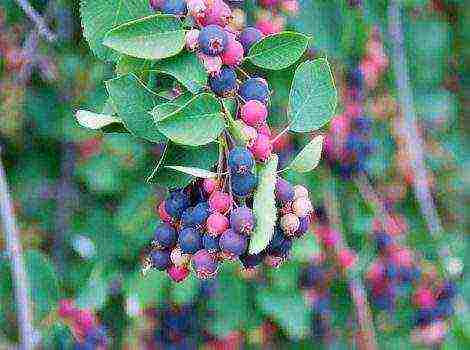Content
Most often in flower beds you can find classic tubular daffodils, which are the most popular inhabitants of spring flower beds. But besides them, there are many other different varieties.
We have made a selection of the most beautiful varieties of daffodils, whose amazing flowers will adorn any garden plot.
Crackington
A variety of double daffodils with very bright and catchy flowers. Crackington daffodils have a rich yellow color with an equally striking orange center. Of all the varieties of the terry group, this variety is considered one of the earliest (blooms in April). Flowers with strong peduncles, which allows them to be grown in any corner of the garden. The plant gives an excellent cut.
|
Appointment |
Group |
Stem height |
Bloom |
|
Terry |
45-60 cm |
Early April - mid april |
|
Ice King
Terry variety of daffodils with amazing flowering. The flowers are luxurious and large (can reach a diameter of 13 cm), creamy white and bright yellow shades. By the end of spring, they become creamy. The buds feature a corrugated crown. The first flowers appear at the end of April and last for 2-3 weeks. The Ice King variety is suitable for creating exquisite spring beds and flower beds, as well as for decorating borders.
|
Appointment |
Group |
Stem height |
Bloom |
|
Terry |
35-45 cm |
End of April - beginning of May |
|
Mount Hood
This variety of tubular daffodils blooms in April-May. The flowers are snow-white, very large - up to 13 cm, held on strong peduncles. The color of one bud can vary from creamy white to ivory. The color intensity of daffodils depends on the weather conditions: the warmer the spring, the richer the color will be.
The variety is especially appreciated for its delicate color and light aroma. Mount Hood daffodils bloom early and are suitable for planting anywhere in the garden: in a flower bed, on an alpine slide, in a curb, on a rabat, between bushes. Suitable for cutting.
|
Appointment |
Group |
Stem height |
Bloom |
|
Tubular |
40-50 cm |
End of April - beginning of May |
|
Pink Champagne
The variety belongs to the group of double daffodils with crown flowers. In one flower, you can observe a mixture of white and bright pink shades. The multi-colored petals are randomly arranged, which gives Pink Champagne a special elegance. These daffodils bloom in early May, suitable for growing in a flower garden or along a path.
|
Appointment |
Group |
Stem height |
Bloom |
|
Terry |
35-40 cm |
Early may |
|
Precocious
A tall variety of large-crowned daffodils with a massive bud with a large perianth. A distinctive feature of these daffodils is an openwork pinkish crown. The edges are of a darker shade, very strongly corrugated. The plant blooms in May and is great for landscaping the garden, as well as decorating the house with cut bouquets.
|
Appointment |
Group |
Stem height |
Bloom |
|
Large-crowned |
40-45 cm |
Mid may |
|
Rosy Cloud (Rosy Cloud)
The Rosy Cloud variety of double daffodils of white-pink color is considered the most unique of all existing ones, because they combine coloration and terry that are atypical for these plants. The openwork crown of flowers of this variety is corrugated much stronger than that of all other varieties.In addition, the color of the flowers can change (its saturation depends on the weather conditions). These daffodils look great anywhere in the garden and are also great for cutting.
|
Appointment |
Group |
Stem height |
Bloom |
|
Terry |
30-50 cm |
End of April - beginning of May |
|
Spellbinder
Medium early variety of tubular daffodils. Blooms in late April - early May. The flowers are lemon yellow, lighter at the center, 10 cm in diameter. The peculiarity of this variety of daffodils is that their funnel-shaped tube changes color from yellow to white for a couple of days.
|
Appointment |
Group |
Stem height |
Bloom |
|
Tubular |
35-45 cm |
End of April - beginning of May |
|
Taurus
An unusual variety of large-crowned daffodils, which with its flowers at the same time resembles a lily and a carnation. The diameter of the flower is 10-12 cm, the height of the peduncle is up to 50 cm. The tall large crown (lemon-yellow at the base and delicate apricot at the edges) looks spectacular against the background of white petals. The variety is suitable for cutting, as it has tall and strong flower stalks. In the garden, daffodils of this variety look good in group plantings. They can also be planted along the paths.
|
Appointment |
Group |
Stem height |
Bloom |
|
Large-crowned |
30-50 cm |
End of April - beginning of May |
|
Thalia (Waist)
An early variety of tubular daffodils, which can delight with flowers as early as March. Flowering is intense and quite long for daffodils. Small white flowers contrast harmoniously with dark green narrow foliage. Due to its low height and neat shape, the variety is suitable for planting in the foreground of a flower garden or alpine slide, as well as for home distillation.
|
Appointment |
Group |
Stem height |
Bloom |
|
Triandrus |
30-40 cm |
End of March - beginning of April |
|
***
Daffodils have long adapted to the changeable climate of the middle zone, therefore they are considered quite traditional plants for a classic garden. However, if you competently approach the choice of varieties, you can grow such specimens that will surprise even the most sophisticated flower growers with their beauty.
We present to your attention a catalog of daffodil varieties with photos and names
Daffodils tubular: varieties with photos and names
Large-crowned daffodils: varieties with photos and names
Small-crowned daffodils: varieties with photos and names
Botanical daffodils: varieties with photos and names
see also
| Narcissus Narcissus has long worried people and left few people indifferent. Legends were dedicated to him - what is the legend about the beautiful young man Narcissus, who died of love for his own image, in China the narcissus is considered a symbol of good luck and wealth in the New Year, in Japan it is a symbol of purity. |
|
| Daffodils have faded: what to do next?
Daffodils are relatively unpretentious, but after flowering they need a little care so as not to lose their varietal properties and decorate the garden for many years. What should be done after the daffodils have faded? |
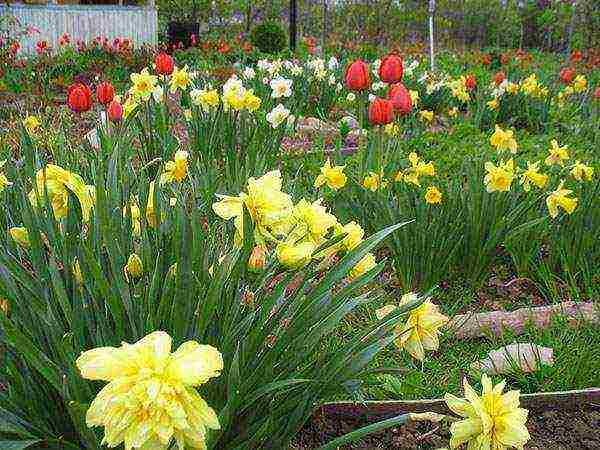 Not everyone knows, but there are many varieties of daffodils. Plants differ in the type of flower, the method of growing, the period and duration of flowering. Consider the most popular and most beautiful varieties of daffodils, their photos and the correct name.
Not everyone knows, but there are many varieties of daffodils. Plants differ in the type of flower, the method of growing, the period and duration of flowering. Consider the most popular and most beautiful varieties of daffodils, their photos and the correct name.
Poetic daffodil
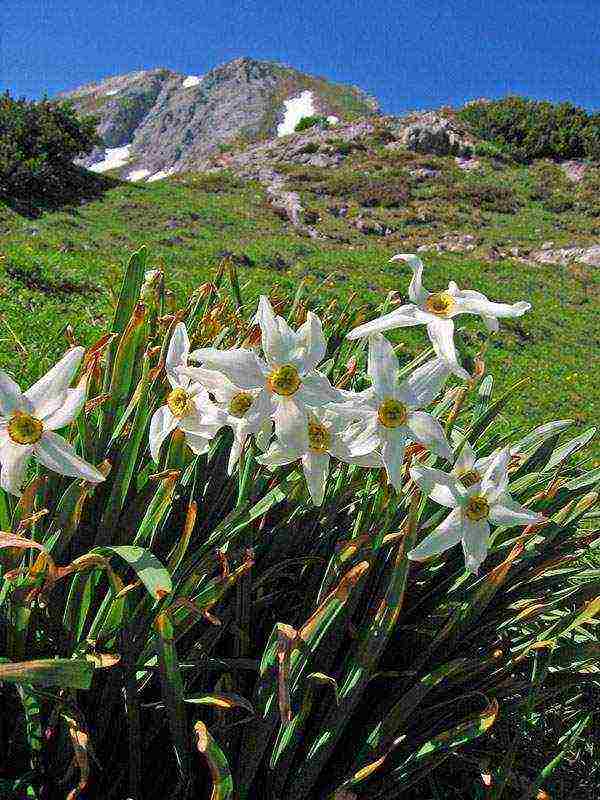 The flower was brought from the mountainous regions. In nature, the poetic daffodil lives on hills, near water bodies and springs. The species was originally bred near the Mediterranean Sea and not far from Italy. The plant grows rapidly and blooms among chestnut trees. For full development, the flower needs moderate moisture and direct sunlight. The flower grows up to 50 centimeters in height. Propagated by bulbs that are in the shape of a ball or chicken egg, with a pointed end. One bush of the poetic daffodil produces up to five flat, long leaves.They are bright green in color. Flowers bloom on a single branch, white, heads look down. Inside they have a crown of bright yellow color.
The flower was brought from the mountainous regions. In nature, the poetic daffodil lives on hills, near water bodies and springs. The species was originally bred near the Mediterranean Sea and not far from Italy. The plant grows rapidly and blooms among chestnut trees. For full development, the flower needs moderate moisture and direct sunlight. The flower grows up to 50 centimeters in height. Propagated by bulbs that are in the shape of a ball or chicken egg, with a pointed end. One bush of the poetic daffodil produces up to five flat, long leaves.They are bright green in color. Flowers bloom on a single branch, white, heads look down. Inside they have a crown of bright yellow color.
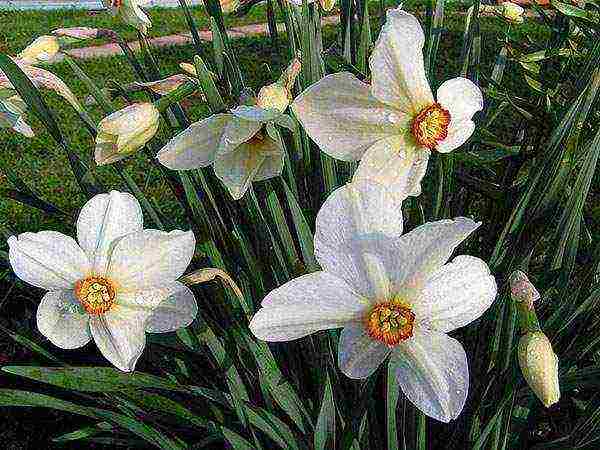 The species was first bred in 1538. The Italians liked the daffodil for its strong fragrance. The size of the blossoming flower reaches six centimeters. The flower-bearing stalk grows longer than the leaves and can reach fifty centimeters. The plant emerges from the ground in early spring, is actively growing and begins to bloom in the month of May. Flowering period up to 12 days.
The species was first bred in 1538. The Italians liked the daffodil for its strong fragrance. The size of the blossoming flower reaches six centimeters. The flower-bearing stalk grows longer than the leaves and can reach fifty centimeters. The plant emerges from the ground in early spring, is actively growing and begins to bloom in the month of May. Flowering period up to 12 days.
When the temperature drops below 10 degrees in winter, the flower requires shelter.
After reviewing the photo with the daffodil and the description of the variety, you can choose the plant you like of the poetic daffodil and breed it on your site.
Yellow daffodil
 The representative of this variety has a second name - false daffodil. The flower was brought from France, Germany and southern Italy. Grows well on the slopes of the Caucasus Mountains. The yellow daffodil grows short. An adult plant reaches 30 centimeters. Propagated by bulbs, the diameter of which does not exceed 5 centimeters. They are round, less often oval. One flower blooms on a flower stem, which reaches a diameter of 4 cm. The flower, in the process of active growth, releases thin, dark green leaves, which are located 10 centimeters below the flower.
The representative of this variety has a second name - false daffodil. The flower was brought from France, Germany and southern Italy. Grows well on the slopes of the Caucasus Mountains. The yellow daffodil grows short. An adult plant reaches 30 centimeters. Propagated by bulbs, the diameter of which does not exceed 5 centimeters. They are round, less often oval. One flower blooms on a flower stem, which reaches a diameter of 4 cm. The flower, in the process of active growth, releases thin, dark green leaves, which are located 10 centimeters below the flower.
Inside the blossoming flower there is a crown, bright yellow in color with a corrugated uneven edge. The flowering period of the yellow daffodil begins in mid-May. It lasts no more than 15 days. The flower has been bred and introduced into garden culture since 1500.
Thanks to this variety, many forms of the plant have been bred by crossing.
Gardeners use yellow daffodil for ennobling near house plots and rocky gardens, planting them next to tulips, a royal crown, in mixed plantings and compositions with juniper.
White daffodil
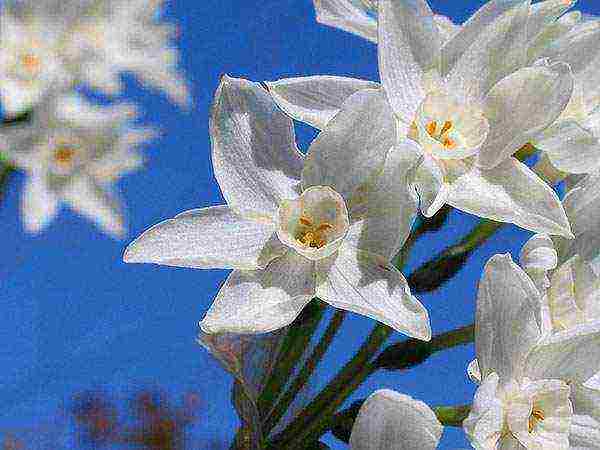 The flower was brought from the Iberian Islands. It grows well on mountain slopes enriched with picturesque vegetation, including abundant grass. White daffodil can be seen in acidified soil or pine forests. An adult flower reaches 35 centimeters. Propagated and planted with bulbs. They are no more than 4 cm in size and are spherical. The flower has thin, multiple green leaves. The flower-bearing stalk does not exceed 23 centimeters. The flower is white, like the inner crown.
The flower was brought from the Iberian Islands. It grows well on mountain slopes enriched with picturesque vegetation, including abundant grass. White daffodil can be seen in acidified soil or pine forests. An adult flower reaches 35 centimeters. Propagated and planted with bulbs. They are no more than 4 cm in size and are spherical. The flower has thin, multiple green leaves. The flower-bearing stalk does not exceed 23 centimeters. The flower is white, like the inner crown.
White daffodil has been introduced into culture since 1579. It begins to grow actively in mid-spring. By the end of May, the flower dissolves flowers, which are fragrant for no more than 10 days.
When grown in low temperatures, daffodils should be covered during the cold season.
Pink daffodil
 The flower was brought from western Italy in 1520. At about the same time, the variety was introduced to the culture in the south of France. Pink daffodil differs from other plant species in its rather high size. The flower reaches 45 centimeters. The leaves are dark green and wider than that of other species by 0.5 centimeters. Differs in the color of the flower itself. During the flowering period, 1 bud is located on the pedicel. The flower has a white color with a pale pink crown, quite unusual for this group of plants.
The flower was brought from western Italy in 1520. At about the same time, the variety was introduced to the culture in the south of France. Pink daffodil differs from other plant species in its rather high size. The flower reaches 45 centimeters. The leaves are dark green and wider than that of other species by 0.5 centimeters. Differs in the color of the flower itself. During the flowering period, 1 bud is located on the pedicel. The flower has a white color with a pale pink crown, quite unusual for this group of plants.
Pink daffodil propagates with the help of bulbs. In an adult plant, they can reach 5 centimeters. Daffodil blooms in early May. To preserve the flower, it is better to dig up the bulb for the rest period and keep it in a dark place until the onset of spring. Pink daffodil can not only beautify the garden area, but also surprise guests. The plant will draw attention to the flower bed in any design.
Narcissus Tete-a-Tete
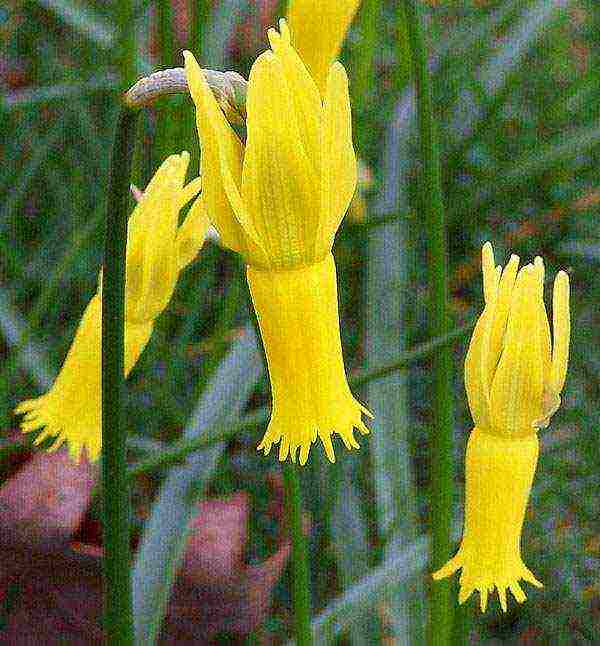 The flower belongs to the cyclamen group. Narcissus Tet-a-Tet has been cultivated since 1584. Brought from the mountains of the Caucasus and Germany. The plant reaches a short stature.Most often, the daffodil does not exceed 25 centimeters in height. One inflorescence is located on the peduncle. The bud has a drooping appearance, strongly lowered to the ground. The flower is bright yellow in color with unusual petals raised up.
The flower belongs to the cyclamen group. Narcissus Tet-a-Tet has been cultivated since 1584. Brought from the mountains of the Caucasus and Germany. The plant reaches a short stature.Most often, the daffodil does not exceed 25 centimeters in height. One inflorescence is located on the peduncle. The bud has a drooping appearance, strongly lowered to the ground. The flower is bright yellow in color with unusual petals raised up.
Narcissus Tet-a-Tet blooms from the beginning of May. Has a pleasant aroma. Drought intolerant. Plants are planted along curbs and low fences. It grows well and produces new globular bulbs. During wintering, the flower is dug up and stored in a dark, cool place until spring.
In ancient Rome, daffodils were considered flowers to symbolize victory. After the battle, the winner was hung a garland of this plant around his neck. Spectators brought live bouquets to some heroes of the fights.
Terry daffodils
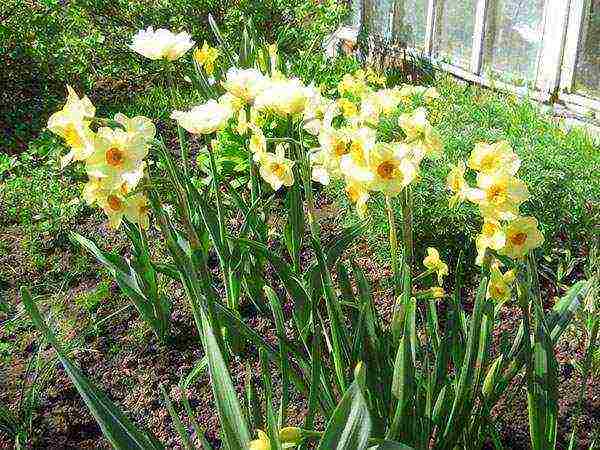 Most varieties of double daffodils are imported from South America. The plant loves a humid climate and does not tolerate prolonged drought. This group includes several types of daffodils, varieties with a photo, name and description are presented below.
Most varieties of double daffodils are imported from South America. The plant loves a humid climate and does not tolerate prolonged drought. This group includes several types of daffodils, varieties with a photo, name and description are presented below.
Gay Challenger
 A low-growing plant with dark green leaves 0.5 centimeters wide. On each peduncle there is 1 flower of extraordinary beauty. Terry daffodil during the flowering period has a yellow flower with a bright orange crown, uneven size. The bud size can exceed 7 centimeters. Flowers decorate bouquets, it has no equal when cutting. It begins to bloom at the end of May.
A low-growing plant with dark green leaves 0.5 centimeters wide. On each peduncle there is 1 flower of extraordinary beauty. Terry daffodil during the flowering period has a yellow flower with a bright orange crown, uneven size. The bud size can exceed 7 centimeters. Flowers decorate bouquets, it has no equal when cutting. It begins to bloom at the end of May.
Variety Texas
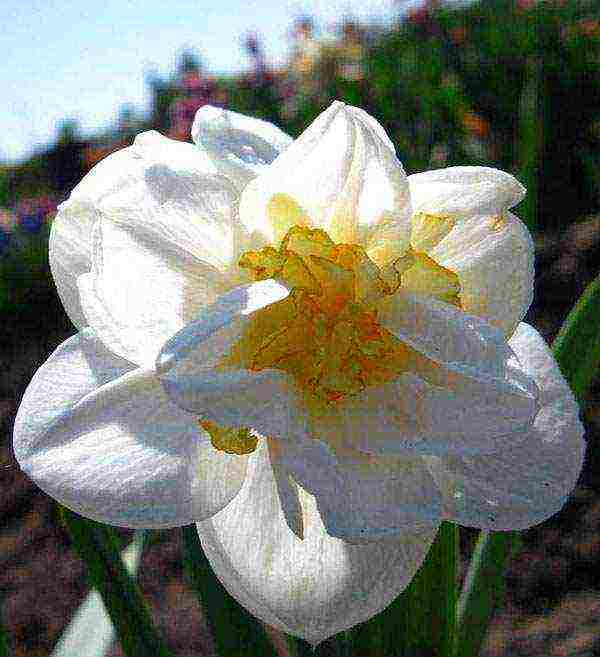 Belongs to the group of terry daffodils. The flower is large in size, has a double crown. The color is white - yellow or pale pink. Narcissus is unpretentious in cultivation. Loves rich and moist soil. Brought from Germany and Italy. The flower has been introduced into cultivation since 1565. Texas is great for group boarding. Suitable for decorating flower arrangements, may not fade for a long time without water when cut.
Belongs to the group of terry daffodils. The flower is large in size, has a double crown. The color is white - yellow or pale pink. Narcissus is unpretentious in cultivation. Loves rich and moist soil. Brought from Germany and Italy. The flower has been introduced into cultivation since 1565. Texas is great for group boarding. Suitable for decorating flower arrangements, may not fade for a long time without water when cut.
Terry daffodil of the Texas variety has an aromatic fragrance during the flowering period from mid-May. When wintering cold, it is better to cover.
Narcissus Ice King
 The plant was bred in Italy and has been planted by gardeners since 1850. Narcissus Ice King reproduces vegetatively. The bulb of an adult plant does not exceed 5 centimeters. What does a daffodil look like?
The plant was bred in Italy and has been planted by gardeners since 1850. Narcissus Ice King reproduces vegetatively. The bulb of an adult plant does not exceed 5 centimeters. What does a daffodil look like?
The photo shows the flower family. The plant has wide leaves, located below and at the level of the bud. Each peduncle has one white flower with a light yellow crown. Narcissus Ice King is distinguished by its large flowers, the size of which reaches 11 centimeters.
Grows in abundantly moist soil. Does not tolerate prolonged drought.
Garden plots are ennobled with a flower, it is used in flower arrangements. Narcissus Ice King begins to bloom from the beginning of May. Will delight the gardener with beautiful flowers until the end of the month.
What does a Tahiti daffodil look like?
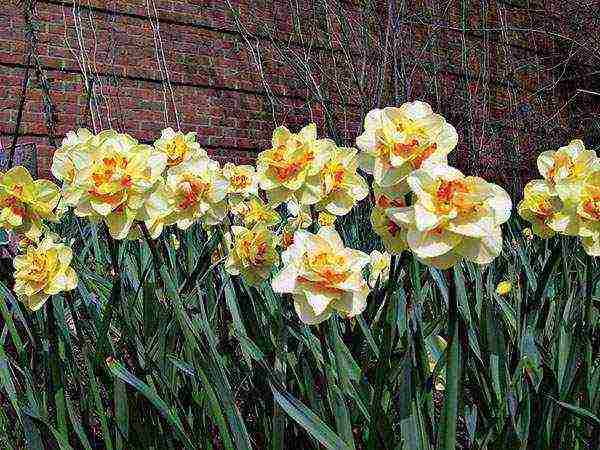 The plant has large double flowers reaching a size of 10 centimeters. The color of the main petals is light yellow. Inside there is a red - orange crown. Narcissus Tahiti grows up to 35 centimeters during the period of active growth. It has narrow dark green leaves that are located below the buds. Each flower has a separate peduncle.
The plant has large double flowers reaching a size of 10 centimeters. The color of the main petals is light yellow. Inside there is a red - orange crown. Narcissus Tahiti grows up to 35 centimeters during the period of active growth. It has narrow dark green leaves that are located below the buds. Each flower has a separate peduncle.
The plant reproduces vegetatively, grows in areas near the house. It tolerates direct sunlight well, loves moist soil. It grows well in groups. It has been actively growing since mid-May. By the end of flowering it fades, but does not lose its pleasant aroma.
Narcissus Replit
 The plant reproduces vegetatively. It tolerates sunlight well and can grow in the shade of trees. The plant has wide leaves of a dark green color, located at the level and below the inflorescences. There can be several buds on one pedicel. Large-sized flowers with light pink petals. Terry crown with peach tint. The plant reaches a height of 50 centimeters. Narcissus Replit is used for landscaping garden plots.
The plant reproduces vegetatively. It tolerates sunlight well and can grow in the shade of trees. The plant has wide leaves of a dark green color, located at the level and below the inflorescences. There can be several buds on one pedicel. Large-sized flowers with light pink petals. Terry crown with peach tint. The plant reaches a height of 50 centimeters. Narcissus Replit is used for landscaping garden plots.
The flower loves richly enriched, moist and loose soil.Used in flower arrangements.
Narcissus Rip Vann Winkle
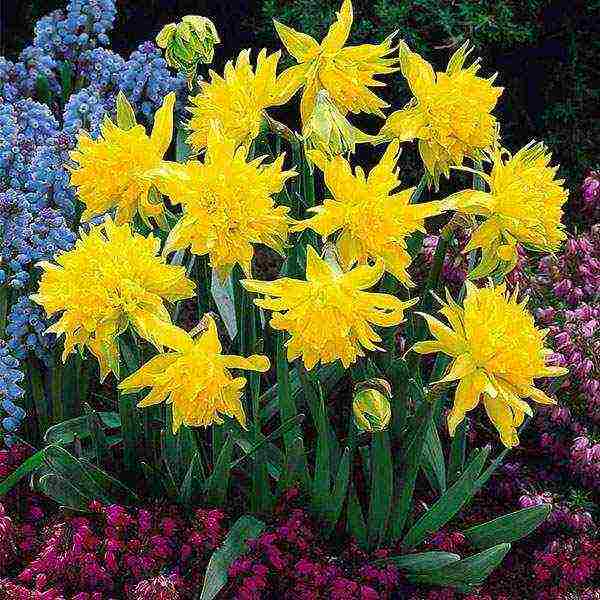 The flower can be located and bloom, being in an open area and in the shade of trees. A low-growing plant, reaching a maximum length of 30 centimeters. It has wide leaves that do not grow to flowers. Narcissus Rip Van Winkle grows in moist and rich soil, does not tolerate drought. Flowers and crowns are double, bright yellow. Each peduncle has a single bud. The plant is dug up after flowering and planted in open ground at the end of winter.
The flower can be located and bloom, being in an open area and in the shade of trees. A low-growing plant, reaching a maximum length of 30 centimeters. It has wide leaves that do not grow to flowers. Narcissus Rip Van Winkle grows in moist and rich soil, does not tolerate drought. Flowers and crowns are double, bright yellow. Each peduncle has a single bud. The plant is dug up after flowering and planted in open ground at the end of winter.
Narcissus Obdam
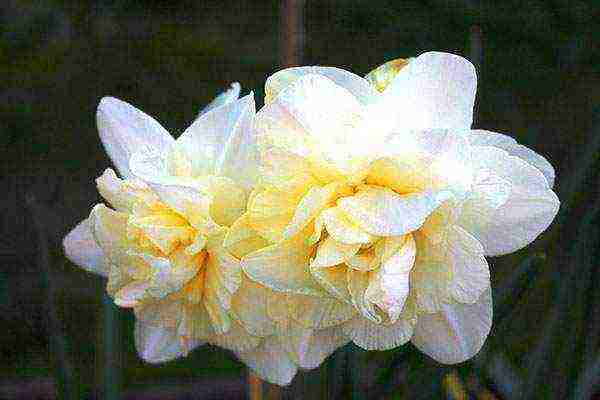 The plant belongs to the terry group. Narcissus Obdam is fragrant with a delicate and refined aroma. Flowers are located on a separate pedicel. They have a delicate beige shade. Large buds. When unfolded, they can exceed 10 centimeters. The plant grows large. At the end of active growth, it can exceed 50 centimeters.
The plant belongs to the terry group. Narcissus Obdam is fragrant with a delicate and refined aroma. Flowers are located on a separate pedicel. They have a delicate beige shade. Large buds. When unfolded, they can exceed 10 centimeters. The plant grows large. At the end of active growth, it can exceed 50 centimeters.
The bulbs are planted in fertilized soil at the end of summer. In early spring, the daffodil Obdam begins to sprout from the ground. In mid-May, the plant pleases others with its appearance. The flowering period lasts no more than 12 days. By the end of this period, the flowers fade to a white hue, but do not lose their delicate aroma. Gardeners are advised to plant tubers in open sunny areas or in the shade of trees.
The tubers of the plant are large enough, up to 6 centimeters. Narcissus Obdam is planted in garden plots in groups.
Interesting about the species and varieties of narcissus - video
2015 Harvest Daffodil Catalog1. Tubular daffodils (trumpet)
BRUSHINE
BROUGHSHANE (G.L. Wilson, previously 1932)
1W-W Crown and tube are lemon at the beginning of flowering, then turn white. The flower is large.
BEW GEST
BEAU GESTE (W.F. Leenen, 1977)
YYW-Y Yellow, monochromatic, very large flower. Height 35cm.
GALAXY STAR
GALACTIC STAR (K.van der Veek, 2008)
1YYW-W. Large two-tone, very delicate light yellow with a cream crown. Height 35 cm. Great!
GOLDEN HARVEST
GOLDEN HARVEST (Warnaar & Co., formerly 1920)
1 (a) Y-Y Bright yellow with an equally long corrugated crown.
LORIKIT
LORIKEET (G.E. Mitsch, 1977)
“1 Y -P Yellowish cream with an intense pink crown. Height 40 cm. The crown changes color from yellow to intense pink. (tubular.)
MOUNT HUD
MOUNT HOOD (P. van Deursen, before 1938)
1 (c) W-W Solid white.
PINK SILK
PINK SILK (R. Havens, 1980)
“1 W -P White perianth, large salmon-pink crown. Height 30 cm. AM 2009.
SENTINEL
SENTINEL (A.J. Bliss, previously 1931)
1 (b) W-Y The flowers are very large, white, the crown is peachy, wide and beautifully corrugated.
THUNDERBOT
THUNDERBORT (M.J. Jefferson-Brown, 1975)
1 Y-O Fiery yellow, the crown is even brighter, wide open and strongly corrugated.
2. Large-crowned daffodils (large-cupped)
AVALON
AVALON (Mrs H. K. Richardson, 1977)
2 Y -W Perianth bicolor: from white center to greenish-yellow at the tips of the petals, white crown. Height 30 cm. Wonderful!
AGAKHON
AGATHON (A.M. Wilson, previously 1949)
2 (a) Y -Y Bright yellow with even brighter corrugated crown.
ICE FOLIS
ICE FOLLIES (Konynenburg & Mark,)
2 (c) W-W Very early. Almost pure white, flower diameter 9.5 cm, cup-shaped crown, 3.5-4 cm in diameter, cream.
BERLIN
BERLIN (W.F. Leenen, 1980)
2 Y -YYO Yellow, strongly corrugated yellow crown with a wide orange border.
GENTLE JIGHT
GENTLE GIANT (Van Eeden Goohof, 1995)
2 W-O Large creamy white, orange corrugated crown.
ISTER BONNE
EASTER BONNET (Hon. Mrs B.B. Ponsonby, 1956)
2 (b) W-YYP White, nicely ruffled crown, large, light peach pink.
QUIRINUS
QUIRINUS (G. Lubbe & Son, previously 1939)
2 (a) Y-O Bright yellow with even brighter corrugated crown.
Curley
KERLEW (J.N. Hancock & Co., 1980)
2 Y-WWY Light yellow, the crown is brighter, double (2-3 rows), strongly corrugated along the edge.
CONFUOCA
CONFUOCO (G.A. Uit den Boogaard, previously 1946)
2 (a) Y -R Large light yellow, bright yellow crown, corrugated, wide open.
CORDIAL
CORDIAL (Murray W. Evans, 1970)
2 W-P Small flower, pink crown, corrugated, elongated.
LADY LACQUER
LADY LUCK (Warnaar & Co., formerly 1951)
2 Y-O Lemon yellow, flower diameter 7.5 cm, brick crown, corrugated.
PINK SELECT
PINK SELECT (L. van Leeuwen & Son, previously 1947)
2 (b) W-OOP Creamy white with a corrugated salmon orange crown that thickens towards the edge.
SNOW FRILLS
SNOW FRILLS (G.E. Mitsch, 1977)
2 YYW-W Lime pink with a light center near the crown and a white corrugated crown. Height 40 cm.
SNOWTIP
SNOWTIP (K.van der Veek, 2008)
«2 Y-Y / W Light yellow, bright yellow strong-fringed crown. The tips and edges of the crown are, as it were, covered with snow. Height 35 cm. TGA 2008.
TAURUS
TAURUS (J.A. Hunter, 1977)
2W-W White, yellow crown with pink edging, corrugated. Height 45 cm.
FLOWER RECORD
FLOWER RECORD (J.W.A. Lefeber, previously 1943)
2 (b) W-YYO Very tall, creamy white, flower diameter 8 cm, tube yellow with lighter stripes, corrugated, with an orange groove.

